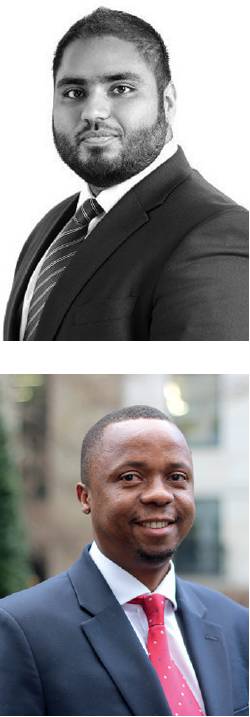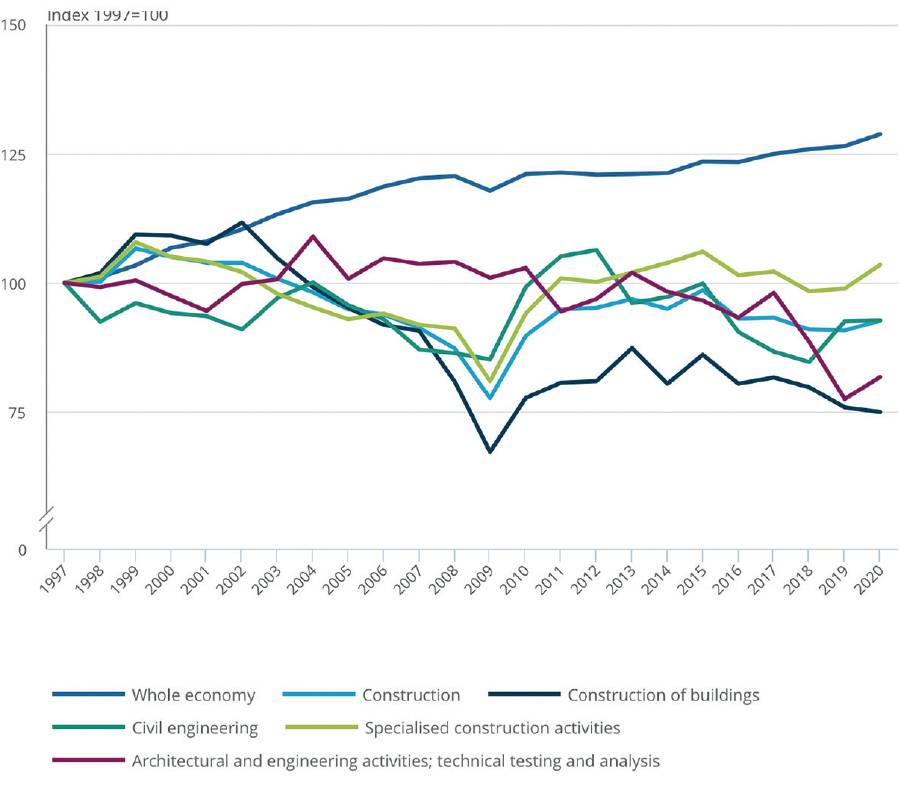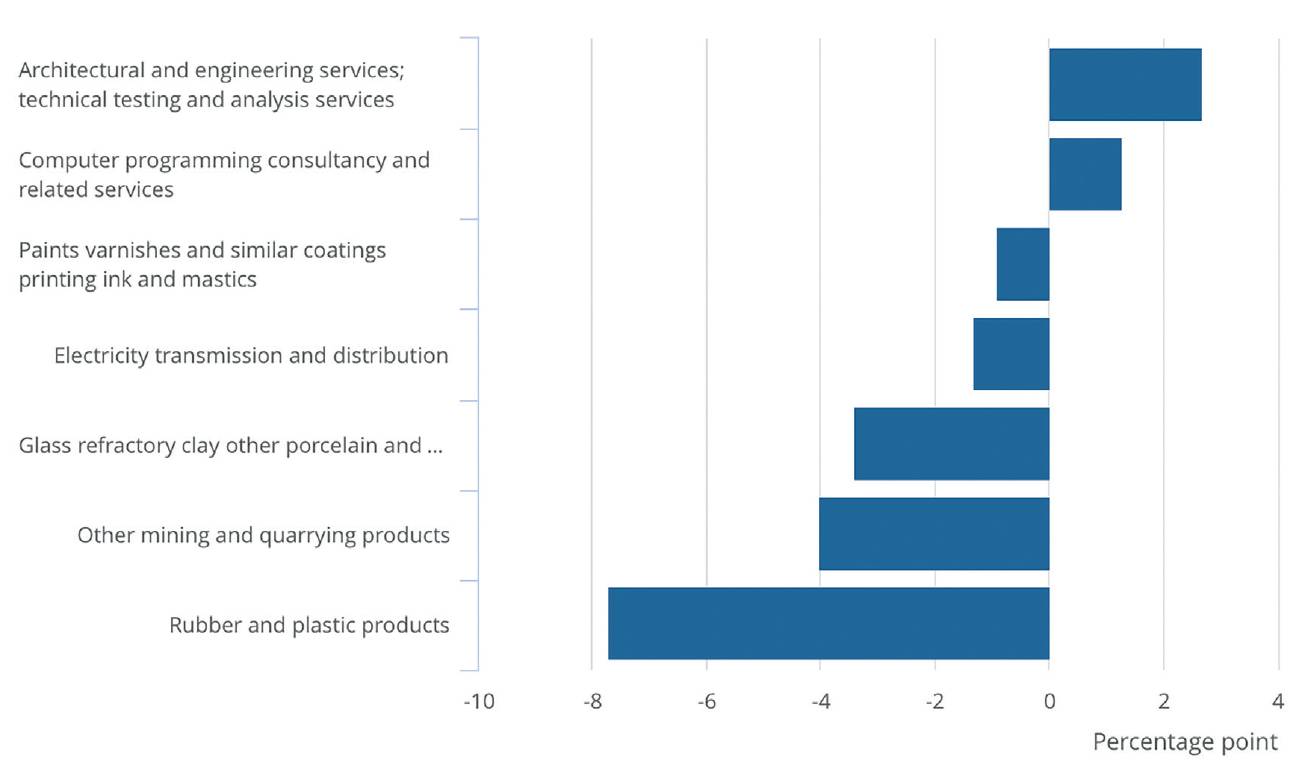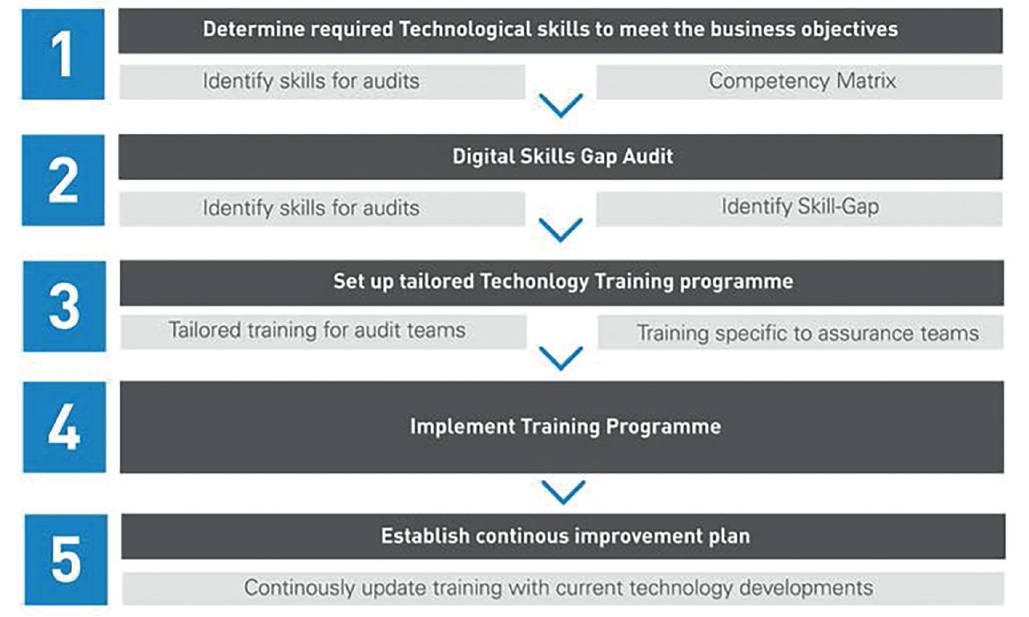Cost assurance and audits on infrastructure projects and contracts
Part 7: Technology Imran Akhtar, Director, Turner & Townsend and Elliot Patsanza, Partner, Ridge & Partners

THIS output explores current, emerging, and aspirational technologies from a wider assurance perspective on infrastructure projects and the impact technology may have on audit and assurance in creating efficiency, productivity gains and capturing risks to be considered early.
Introduction
The UK construction industry has faced challenges with productivity for decades. Construction, as a sector, is often seen as lagging behind the wider economy (see Figure 1)1.
Whilst elements of the industry like civil engineering have seen productivity gains; improvements still need to be made. Office for National Statistics (ONS) data suggests that there has been a rise in the requirement for services within the industry in comparison to materials (see Figure 2)2. This could be due to the natural efficiencies created during the construction process from better use of materials with less wastage and indicates a shifting focus to ensure that more attention is paid to design and planning projects with a data-centric focus.
Considering this, does technology also have a part to play in audit and assurance? This output explores current, emerging, and aspirational technologies and their impact on audit and assurance, creating efficiency and productivity gains and the risks that need to be considered. Over the last decade, digital technology has transformed the construction industry at a breath-taking speed. We have since evolved from 2D designs to the age of digital twins and augmented reality visualisations. In this key output, we spotlight top trending digital technology and how they impact infrastructure projects and construction contracts.
Trending top three digital technologies impacting assurance and cost auditing
Data analytics
This sits at the heart of the digital technology revolution. ‘Know your Data’ (KYD) and ‘You cannot achieve what you cannot measure’ are prevalent mantras that emphasise the importance of data analytics. Across the field of cost assurance, data analytics has helped auditors manage large volumes of information at high velocity and in many varieties, such as unstructured texts and images. Data analytics now enable auditors to review not just a sample but also the entire data population in real-time, with precision and high levels of certainty. Auditors can now use data analytics to provide clients with a 360-degree view of company financials and a detailed view of accounting records. This offers better insight and improves the efficiency and quality of audits.
Blockchain
This is a shared digital database that stores information in nodes known as blocks linked by cryptography. Each block has limited capacity, and once it is complete, it relates to previously created blocks, and as a new one is made, it is designed to extend the chain. Technology gurus Don and Alex Tapscott define the blockchain as an ‘incorruptible digital ledger of economic transactions that can be programmed to record financial transactions and virtually everything of value’.
Five core principles underpin blockchain technology:
- Members in the blockchain have visibility of all transactions in the chain. No single party has sole control of the stored data. Every member can securely manage the ledger without the need for a central authority to enforce the rules. This removal is a key aspect of blockchain.
- Direct peer-to-peer communications and transactions without the requirement to run through a central control node.
- Users in the blockchain can remain anonymous and behind cryptography if they so choose.
- Each transaction is permanent and cannot be reversed or altered once completed.
- The digital nature enables blockchains to be programmed and tied to computational logic. This allows users to set up algorithms that automatically trigger transactions between nodes.
Smart contracts
These principles can be adapted in engineering and construction and applied to alliancing contracts on infrastructure projects. Another potential use for blockchain technology is in smart contracts, described by IBM as programs stored on a blockchain that run when predetermined conditions are met. They are typically used to automate the execution of an agreement so that all parties can be immediately sure of the outcome without any intermediary involvement or time loss. They can also be used to automate a workflow, triggering the following action when certain conditions; this automation can make projects more efficient and save costs.
Artificial intelligence (AI)
Another potential use for blockchain technology is in smart contracts, described by IBM as programs stored on a blockchain that run when predetermined conditions are met.The term was initially coined in a 1956 document co-authored by John McCarthy. He offered a definition of AI as ‘the science and engineering of making intelligent machines and brilliant computer programs. It is related to the task of using computers to understand human intelligence, but AI does not have to confine itself to biologically observable methods in his 2004 paper.
AI is the development of computer systems with capabilities to perform tasks that mirror human intelligence in the fields of decision making, solving complex problems, increased accuracy and completing high-level computations.
AI is evolving through three distinct development stages:
- Narrow artificial intelligence (NAI) or weak AI machines perform simple predefined tasks. Famous examples are Alexa – Amazon’s digital assistant, Siri, the digital assistant for Apple and self-driving autonomous vehicles. Machines in this stage have no thinking capabilities.
- Artificial general intelligence (AGI), or strong AI, is a futuristic stage in the development and evolution of AI. This is when machines and computers have the capabilities to think and make decisions like humans. There are currently no known machines or computers with AGI. Many scientists believe this stage of AI evolution poses a real threat to the human race and must be governed. In 2014 Stephen Hawkins told the BBC: “The development of full artificial intelligence could spell the end of the human race”
- Artificial super intelligence (ASI) stage is when machines and computers exceed humans’ thinking and decision-making capabilities. Again, this is futuristic, and at present, there are no known machines with ASI.
AI falls into four categories:
- Reactive machine AI machines operate solely based on narrow, predetermined information. They are unable to make future decisions based on past experiences. The most famous AI is the IBM Deep Blue machine that defeated Garry Kasparov, the Russian world chess champion, in 1997.
- Limited memory AI machines can make informed and improved decisions based on past experiences and activities stored in their short-term memory. Autonomous self-driving vehicles fall in this category.
- Theory of mind AI evolves around emotional intelligence to better understand human psychology and decision-making philosophies. This category is still very much in development.
- Self-aware AI is when machines and computers develop self-awareness and grow a conscience. To quote Elon Musk: “AI is a fundamental risk to the existence of human civilisation”.
Impact of AI on audits
As businesses transition to AI and robotics to manage and operate, the business auditors need to gain confidence in the robot’s data processing accuracy and boost their understanding of robotic software. Auditors will have to transform to be supported by robot auditors. Robotic process auditing (RPA) is already being applied to repetitive tasks like revenue and payroll testing.
As businesses transition to AI and robotics to manage and operate, the business auditors need to gain confidence in the robot’s data processing accuracy and boost their understanding of robotic software.
Use of technology in assurance
Planning
The planning of which assurance/audit activities will be undertaken has to consider the use of technology by the client organisation, the supply chain, and the assurer. Planning around these factors will introduce an additional challenge to ensure the approach taken is robust, considers the various interfaces between client and supply chain environments and that the capability of the assurers is suitable to deal with these environments.<
Controls
The control environment may be heavily impacted by technology. For example, smart contracts may streamline several interfaces concerning assessment, certification, and payment processing, limiting the requirement to monitor controls continuously. However, residual risk ensures that the environment is fully understood and that the assurance team has sufficient capability to review these controls.
The construction industry is data-rich, for digitisation a common data environment (CDE) with data securely in the cloud offering a single source of truth over the project lifecycle is vital. Technology with the capability to capture, process data, and secure records that provide seamless integration for analytics and real-time reporting will thrive. Nevertheless, decisions that will impact humans require clear protocols and people skilled at applying judgement like auditors to govern the machines and identify emerging risks.
Sustainable construction means Innovative steps like concrete recycling and eco-friendly materials, e.g. carbon fibres, will be on the rise. AI can minimise waste by predicting reorder of materials. BIM, drones and 3D printers are transforming construction with testing of 3D printing complete structures and prefabricated components that can be safely and efficiently assembled on site. Prefabs can streamline processes and eliminate idle time.
Drones can monitor site productivity, with real-time drawings, digital records of works and completion dates keeping clients informed. High-resolution drone cameras are conducting surveys rapidly and accurately with dynamic 3D models or topographical maps that are more cost-effective than aerial imagery. Predictive analytics and AI can use data to predict risks and design options. Drones can enable remote surveying with precision reducing costly BIM design errors, and VR can be used in testing.
Machine learning and predictive analytics help plan with resources, productivity and site safety. As construction embraces AI, driverless cars may soon replace onsite drivers. The role of technology is fundamental. Our steering group continues to set the benchmark for sharing best practice and leveraging technology for cost assurance on infrastructure projects and contracts.
Cecelia Fadipe FCMA, Director, CFBL (Consulting)

Analytics/testing
The use of technology introduces new ways for information and data to be collated and tested to provide assurance that costs have been incurred and presented accurately, for the purposes of the project, that are in line with the contract conditions. The following broad technologies can help achieve efficiencies and optimisations in the testing phase for an assurance exercise.
Big data/cloud-based systems
Undertaking more comprehensive testing and analytics requires access to the whole dataset population. This is becoming more prevalent in effective programmes where the client may introduce a data platform to collate all cost data submitted by the tier one supply chain. However, the challenge remains to ensure that cost data and information exists layers down within the supply chain to a comprehensive level of granularity and that this can also be collated. Analysing the whole dataset allows for the assurer to provide a more comprehensive view and more definitively conclude against risks that have been identified. Whilst the form of contract will dictate the level of audit access/ detail required, there should be a collective effort by the client and supply chain to maintain a complete, consistent and comprehensive dataset to support the programme.
AI/Machine Learning

Figure 1: Productivity growth has been slow in construction industries compared with the whole country. Output per hour worked, construction industry and sub-industries and whole economy, UK, 1997 to 2020, index 1997 = 100.
Maintaining a consistent and comprehensive dataset also allows for deep analytics to be designed and embedded within the testing approach. Whilst logic can be created to automate standard tests (such as checks for non-compliance against certain contract conditions) more detailed logic can be developed that is able to learn from data previously submitted and develop insights into how cost overtime is being expended (such as looking at the movement/use of resources, supply chain involvement, behaviours of how cost is coded/described).
This logic would be developed for each supplier and further through the supply chain, allowing a much more forensic approach to cost analysis with relatively little effort than more manual efforts. Machine learning could also be used across multiple datasets and data points (i.e. cost, programme and contract data) using structured and unstructured data to develop logic continuously and a more robust testing approach.
Reporting
Technology has already positively disrupted how audit results can be communicated to stakeholders. The use of software like IDEA, Tableau and Power BI represent new ways to visually present information, findings and analytics that were not as prevalent 10 years ago. Providing a visual representation of information, particularly in large and complex datasets, allows the user to easily digest the key messages. Going further, dynamic live cost reporting and dashboards are providing a greater level of control to key individuals within the client organisation (as well as the supply chain) to make better-informed decisions using the whole dataset and not just subsections of it.
The construction industry, particularly the management of contract and subcontractor contracts, might be considered ‘behind the curve’ when it comes to the management of its data – generally speaking. Contracting organisations generate a huge amount of data but can typically be found on people’s desktops, in people’s emails (who may leave the project or organisation), in an unstructured traditional or cloud-based server filing systems and in various contract-mandated data and document control systems. Indeed, there can be ‘official’ and unofficial communications between parties creating two or more versions of the truth. This must change for projects to be more efficient and ultimately save money and make the entire supply chain more profitable.
Greater uptake and the contractual obligation of contract management software such as CEMAR would create a baseline for better contract management between the parties. As the uptake increases, certain obligations can develop with AI to reduce the burden on humans for the more mundane tasks to allow more focus on tasks that require judgement and decisions. Creating a consistent repository of data to be used by third parties who assist in resolving disputes can cut down on the time it takes to resolve them which ultimately ensures better cash flow through the supply chain.
Data is stored in various places and incomplete datasets can result in wasted time. Who did what and when and who said what to whom should be a matter of record, but it is surprising how long it takes to collate this information.
Gary Bone MSc MRICS, Construction Commercial Consultant, Blake Newport
Human aspects

Figure 2 - Construction industry is spending proportionally more on business services, and proportionally less on materials. Percentage point difference in intermediate consumption shares for selected products between 1997 and 2018.
Organisational culture
Assurant teams appear less agile and resistant to adapting to technological changes than other advisory consultants. The inflexible culture is perhaps rooted in hierarchical structures that comprise senior leaders who are generally less conversant with the surrounding technologies. Recent studies by McKinsey Consulting have shown that firms embracing diversity at senior and board levels have shown a sharp increase in adopting and applying digital technologies to improve their service levels. When applied appropriately, technology can provide deep insights for the leadership team, which can be used to enhance communication channels between individuals, management, colleagues and their respective organisations.
Training
Training is essential for individuals assuring these complex systems. Individuals must be adequately equipped to understand how new technologies work and where there could be control/system vulnerabilities. Poor digital skills are directly linked to low productivity. Therefore, companies must have robust digital training strategies to increase their staff’s technological quotient (TQ).
TQ has been defined as’ our ability to assimilate or adapt to technology changes by successfully developing and employing strategies to include technology in our work and life. A high TQ consists of the right attitude, capabilities, and decision-making strategies to leverage technology entirely.’
TQ training strategy

Technological quotient training strategy.
Change
Technology is disrupting the assurance sector, and in the past, clients have looked to external assurance teams to provide insights and expert advice. The assurance team have previously been custodians of corporate data. However, with the advent of technology, clients will be able to rely on digital and analytics systems for similar insights. Chief financial officers will increasingly become the custodians of organisational data. In response, assurance teams will have to adapt to the new environment and offer additional value-added services that might include auditing and validating digital systems used by clients. They may require investments in their digital technology and training to fulfil the new services. This will mean providing training to their teams to ensure they remain relevant and keep abreast with digital changes.
The increase in automation will impact the recruitment of assurance teams to complete simple repetitive tasks. New competitors will also emerge for assurance teams as clients turn to digital technologies to provide cost assurance services. Firms such as Apple, Google, and Amazon will also compete and attract employees such as data scientists. Disruptive technologies also profoundly impact auditors, finance, and accounting professionals; this has direct implications for educators, recruitment policies, and staff development needs. Coding and IT skills will need to be introduced and transposed to be part of the education core syllabus.
Human judgement
Human judgement within the assurance space is still critical. This is one reason why the whole field of audit and assurance has not been totally automated and as others might argue, why potentially it may never be. Complex transactions, decisions and outcomes need an element of subjectivity to assess, that may not be suitable to be fully automated and decided by script or code. While low skilled, repetitive accounting and auditing skills may be replaced by technology; the human capabilities to apply instinctive and intuitive judgement and draw insights from data will be required in the immediate and near future.
Imran Akhtar, Director, Turner & Townsend and Elliot Patsanza, Partner, Ridge & Partners
The Multidisciplinary Steering Group on Cost Assurance and Audits on Infrastructure Projects and Contracts: Cecelia Fadipe (chair), CFBL Consulting; Imran Akhtar, Turner & Townsend; Michael Bamber, Capita; Gary Bone, Blake Newport; Adrian Charlton, Atkins/SNC Lavalin; Kathleen Hannon, Scottish Water; Mark Harvey, Crossrail-Transport for London; Chris Haworth, Ridge & Partners; Ian Heaphy, IN Construction, NEC Contract Board; David Heath, Atkins/SNC Lavalin; Victoria Hill-Stanford, Network Rail; Charlotte Hughes, Eversheds Sutherland; Tom Leach, Southern Water; Jim McCluskey (CICES representative), Vinci; Lisa O’Toole, Network Rail (HS2); Elliot Patsanza, Ridge & Partners; Paul Railton, The Orange Partnership; Claire Randall-Smith, Eversheds Sutherland; Matt Yates, Buckingham Group; Darren Ward, The Orange Partnership; Michael Strickland, Network Rail; Shy Jackson, Bryan Cave Leighton Paisner; Jennifer Varley, Bryan Cave Leighton Paisner; David Sharp, Mott Macdonald; David Worsley, Transport for the North
---
1 UK ONS productivity in the construction industry
2 UK ONS productivity in the construction industry